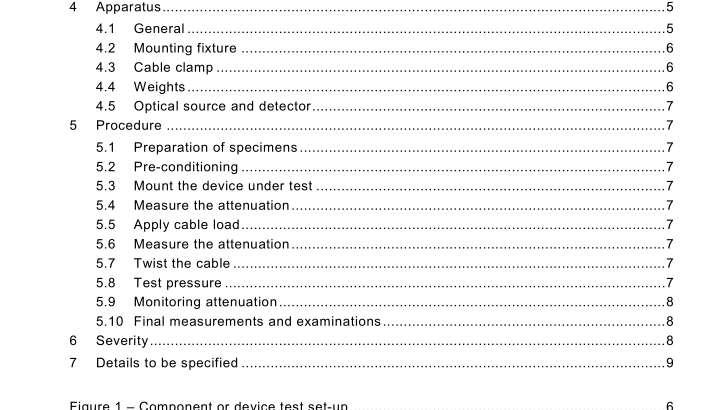IEC 61300-2-5:2009 pdf download – Fibre optic interconnecting devices and passive components – Basic test and measurement procedures – Part 2-5: Tests – Torsion
1 scope
The purpose of this part of lEC 61300 is to determine the ability of the cable attachmentelement of the device under test to withstand torsional loads,while under tension, as might beexperienced during installation and normal service.The scope of the test also includes thoseelements designed for ribbon cables.
2Normative references
The following referenced documents are indispensable for the application of this document.For dated references, only the edition cited applies. For undated references, the latest editionof the referenced document (including any amendments) applies.
IEC 61300-1,Fibre optic interconnecting devices and passive components – Basic test andmeasurement procedures – Part 1: General guidance
IEC 61300-3-1,Fibre optic interconnecting devices and passive components – Basic test andmeasurement procedures – Part 3-1:Examinations and measurements – Visual examination
IEC 61300-3-3,Fibre optic interconnecting devices and passive components – Basic test andmeasurement procedures – Part 3-3:Examinations and measurements – Active monitoring ofchanges in attenuation and return loss
IEC 61300-3-4,Fibre optic interconnecting devices and passive components – Basic test andmeasurement procedures – Part 3-4:Examinations and measurements – Attenuation
IEC 61300-3-6,Fibre optic interconnecting devices and passive components – Basic test andmeasurement procedures – Part 3-6:Examinations and measurements – Return loss
3 General description
The cable-to-device interface,while under a specified tension, is subjected to a torsional loador twisting action to determine the effects of this action on the physical and optical propertiesof the device.
4Apparatus
4.1General
The test apparatus shall be capable of applying simultaneously both tension and a torsionalload or twisting action to the cable-to-device interface. Figures 1 and 2 show the basic partsof a test apparatus for component and closure test set-ups, respectively.
4.2 Mounting fixture Use a fixture to rigidly mount the device under test and hold it in proper alignment throughout the test. The fixture shall allow the device under test to be connected to an optical source and detector for monitoring attenuation.
4.3 Cable clamp The cable clamp is the point at which the torsional load is applied. The cable clamp shall be capable of grasping and securing the cable so that it does not turn or slip in the holder when loads are applied. The clamp shall not crush the optical fibres or cause a change in the attenuation. The cable clamp may consist of a mandrel around which several turns of cable are wrapped and secured. 4.4 Weights Weights or another mechanism for applying a tensile load to the cable clamp are required. Values of recommended loads are given in Table 1 .
4.5Optical source and detector
The optical source and detector used to measure changes in attenuation shall comply withthat specified in lEC 61300-3-4.
5 Procedure
5.1 Preparation of specimens
Prepare the specimens according to the manufacturer’s instructions or as specified in therelevant specification. The device under test shall be terminated onto a sufficient length offibre cable to facilitate interfacing with the optical source and detector.
5.2Pre-conditioning
Pre-condition the device under test for 2 h at the standard test conditions specified inIEC 61300-1,unless otherwise specified in the relevant specification.Measure and record theattenuation of the device under test.
5.3Mount the device under test
The body of the specimen shall be rigidly mounted to a holding plate which is secured in afixed position (see Figure 1). The clamp to which the load can be applied shall be fastened tothe cable in such a manner that the optical fibre or cable is not crushed.The top of the cableclamp shall be 400 mm from the end of the strain relief,if used (see Figure 1).For cablediameters larger than 25 mm, the top of the cable clamp shall be 1 oo0 mm from the end ofthe strain relief. If there is no strain relief,the end of the specimen nearest the cable clampshall be the reference.
5.4 Measure the attenuation
Re-measure the attenuation to ensure that the fixturing and cable clamping have not affectedthe cable’s attenuation.
5.5Apply cable load
Gradually apply the tensile load, as recommended in Table 1 or as specified in the relevantspecification,to the cable clamping fixture,being careful to avoid any sudden jerking orstraining of the cable.
5.6Measure the attenuation
After the load is applied,re-measure the attenuation of the specimen. This value shall berecorded and used as a reference to determine the effects of the twisting motion.
